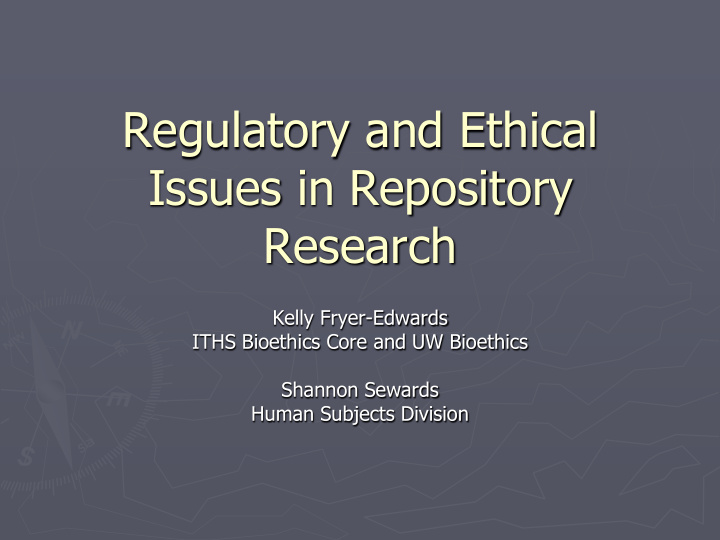



Regulatory and Ethical Issues in Repository Research Kelly Fryer-Edwards ITHS Bioethics Core and UW Bioethics Shannon Sewards Human Subjects Division
Agenda ► Review of Regulatory and Ethical Issues Creating a Repository Storing Data and Managing Using the Repository ► Discussion and Debate
Paradigms Shifting Traditional Research: Biobank Research: (privacy/consent) (collective interests) ► Individual subject ► Families-Communities ► Established ► Unknown future relationship investigators ► Consent for explicit ► Unknown future uses procedures and pursuits ► Altruistic motivations ► Diverse motivations, long-term investments Jeffers, 2001
NIH GWAS Data Sharing Policy ► “The full value of GWAS to the public can be realized only if the genotype and phenotype datasets are made available as rapidly as possible to a wide range of scientific investigators”… http://grants.nih.gov/grants/guide/notice-files/not-od-06-094.html
An Avalanche of Guidelines UK Biobanks Governance Framework (2003) ► Are there alternative consent models? NIH Data Sharing Policy (2003) ► Can we de-identify datasets? OHRP Guidance on Databanks (2004, 2008) ► Who should count as a human subject? NIH Proposed GWAS Data Sharing (2006) ► How can we preserve public trust? Consensus Statement on Personal Genome (2008) ► Should we return results? How can you withdraw?
Creating a Repository ► Diversity of data and specimens Purposes/Types of studies Type, Associated information Prospective/Retrospective Level of identifiability ► Collection methods ► Consent procedures/Waivers ► HIPAA
DNA: “No Longer De - Identified” ► Individual identification is possible with access to a limited number of DNA markers – far fewer than used in GWAS ► Identification requires matching sample: is individual “readily identifiable?” ► Individuals can be identified from pooled genotype data McGuire & Gibbs, Science 2006;312:370-1 Homer et al. PLoS Genet; 4(8): 1-9
Consent: what can we do? ► Opt-out ► Opt-in ► Specific designations of use ► Consent at admission (if hospital-based) ► Consent post-op ► Re-consent for specific use ► How should we decide what to use?
Storage and Management ► Storage: where and how long? ► Data release: what and to whom? ► Governance and oversight: who will perform gatekeeping functions? ► Responsibilities of data recipient: protection, stewardship, and returning results?
IRB Assessment of Risk ► Physical ► Psychosocial ► Group harms ► Privacy/confidentiality
Public Opinion 2008 randomized public survey of 4659 (58.4% response) ► 90% were concerned about privacy protections ► 60% would participate in a biobank if asked ► 48% would provide consent for all research if approved by an oversight board, 42% wanted to be asked for each ► 37% were worried the data could be used against them ► 92% would allow academic researchers to use data; 80% “govt researchers”; 75% industry ► Receiving research results, or $200, made a difference in interest in participating and lessened concerns about privacy ► Kaufman et al. 2009
Benefits of Public Participation Public participation in research can: ► Improve recruitment ► Enhance data collection ► Focus analysis and interpretation ► Facilitate dissemination ► Creates trust Staley K. (2009) Exploring Impact: Public involvement in NHS, public health and social care research. INVOLVE, Eastleigh.
The New Research Ethics Reality 1 st Generation 2 nd Generation Biobanks Biobanks Anonymized or Identifiable Human De-identified Samples Subjects No IRB Review IRB Review Re-contact, Blanket Consent re-consent HIPAA Laws Stewardship Fullerton, et al. Under review
Questions for Discussion ► When is it appropriate to return research results to subjects? ► How much control should subjects have over future uses of their data/specimens? ► Is it possible to prevent group harm? How can this be prevented? ► How to assess risk, especially with genetic research? ► What kind of stewardship or oversight is appropriate for repository research?
OHRP Guidance (2008): Coded Private Information and Specimens “Under certain limited conditions, research involving only coded private information or specimens is not human subjects research.” 45 CFR 46.102 Definitions: (f) Human subject means a living individual about whom an investigator conducting research obtains: (1) Data through intervention or interaction with the individual, or (2) Identifiable private information. http://www.hhs.gov/ohrp/humansubjects/guidance/cdebiol04.pdf
NIH GWAS Data Certification ► In order to minimize risks to study participants, data submitted to the NIH GWAS data repository will be de-identified and coded. the identities of data subjects cannot be readily ascertained or otherwise associated with the data by the repository staff or secondary data users the 18 identifiers enumerated by the HIPAA Privacy Rule are removed; and the submitting institution has no actual knowledge that the remaining information could be used alone or in combination with other information to identify the subject of the data. NIH Points to Consider (November 2007)
Recommend
More recommend